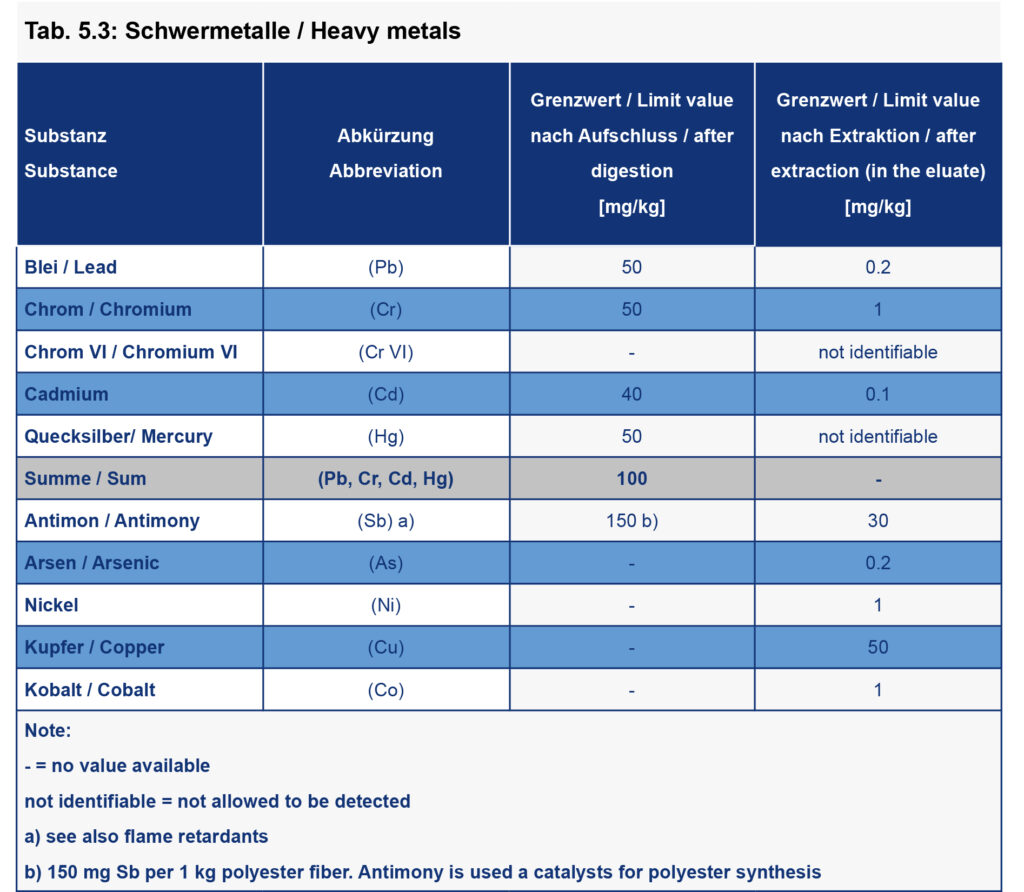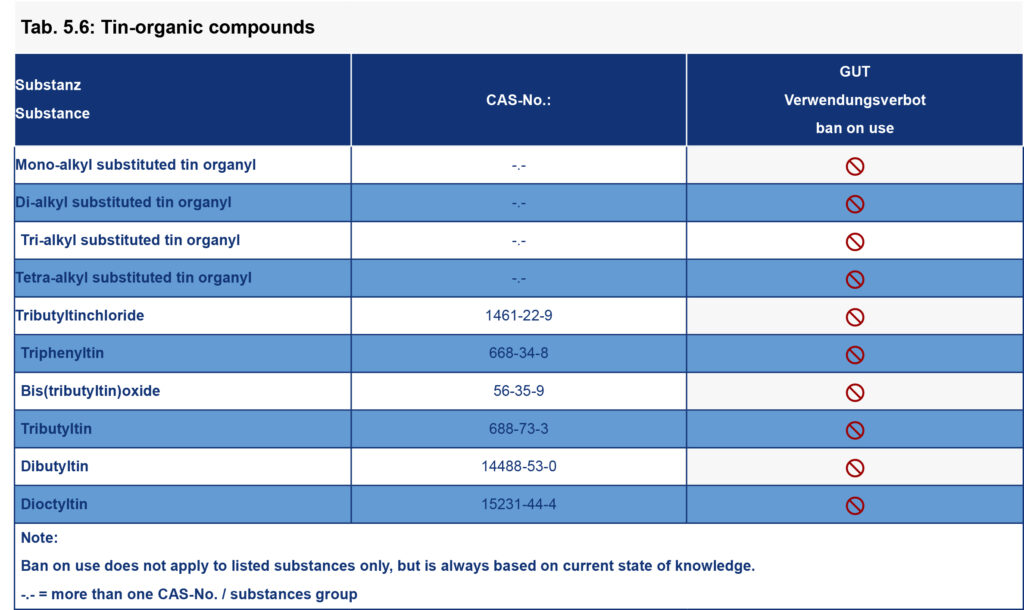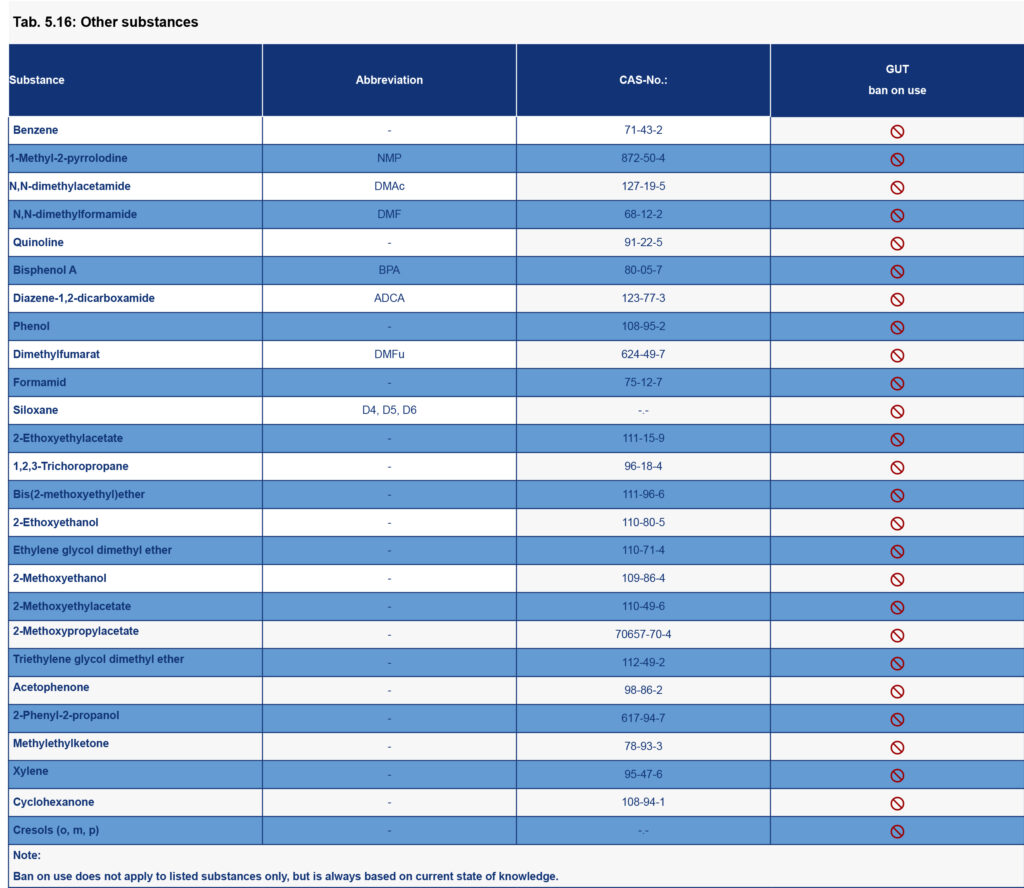Limit values and banned usage
of individual substances or groups
of substances for textile floor coverings
On this page you can find more information about the limit values and banned use of certain substances and groups of substances in the manufacture of textile floor coverings.
Consumer safety & environmental protection
By using both traditional methods of chemical analysis and quicker more modern tests, both the raw materials and the textile floor covering itself can be checked for a wide range of harmful substances. These include heavy metals, plasticisers, biocides, pesticides, POPs (Persistent Organic Pollutants) and the REACH SVHCs. For the substances or groups of substances listed, the GUT system either sets limit values or defines bans on use. These measures have been taken not only with a view to consumer safety, but also to avoid negative effects on the environment. The following information is for individual pollutant classes and the assigned limit values.
Dyestuffs and dyeing auxiliaries (1 of 7)
MORE INFORMATION ON ALLERGENIC AND CARCINOGENIC DYES:
The GUT scheme prohibits the use of dyes classified as allergenic or carcinogenic.

MORE INFORMATION ON AZO-DYES:
Of the approximately 4,000 dyes listed in the Colour Index, about half are Azo dyes and therefore represent the most important and common group of dyestuffs. Azo dyes are produced using carcinogenic amines, and unfortunately there are some still commercially available today. This means that after absorption into the body, the Azo compounds can remain in the metabolism and then form the corresponding aromatic amines from which they were synthesised. Intestinal bacteria and certain enzymes in the liver are capable of causing this process. Under GUT, there is a published list of prohibited Azo dyes.

MORE INFORMATION ON DYEING ACCELERATORS:
Dyeing accelerators (carriers) are organic solvents used as auxiliaries when disperse dyeing is used in the production of some man-made fibres (polyester, acetate, polyacrylonitrile, polyamide), their role is to increase the speed of take up of the dyes by the fibres. Disperse dyeing is particularly important in the production of Polyester (polyethylene terephthalate, PET), as it is the most important man-made fibre for clothing in terms of quantity. Disperse dyeing in this instance is carried out by either using carriers at 95°C, or using high temperature (HT) conditions at 130°C. Generally, carriers are not necessary in HT-dyeing, but they are still used in smaller quantities as levelling carriers to achieve a uniform colour. Carriers are also used for dyeing wool/polyester blends, as the temperature has to be limited to 110- 115 °C due to the wool content. After dyeing, the residual content of the carrier is initially between 5 and 37 g/kg fibre (0.5-3.7 %), depending on the substance and dyeing system used. This content can be reduced by implementing different post-treatments, but it is almost impossible to remove it completely. If dyeing has been carried out according strict measures, the concentration of carriers should be below 0.2%. If less stringent methods are used, the residual can easily reach up to 2.7 %. The use of the listed dyeing accelerators is not permitted within the GUT system.

Heavy metals and plasticisers (2 of 7)
MORE INFORMATION ON HEAVY METALS:
Heavy metals occur naturally in various forms and play an important role in plants, animals and humans. A deficiency of essential heavy metals can certainly result in health issues. However, many heavy metals, such as lead or arsenic, can also cause severe poisoning if too much is ingested. In order to avoid environmental impacts created by certain heavy metals, various limit values have been defined in the GUT system. These relate either to the content of a heavy metal or to the release of the heavy metal under certain conditions. The following information gives an overview of current valid limit values

MORE INFORMATION ON PLASTICISERS:
Plasticisers are substances that are added to brittle materials to make them soft, pliable or stretchable, so that they are easier to work with or achieve certain usage properties. They are contained in large quantities in plastics, varnishes, paints and coatings, sealing compounds, rubber articles and adhesives.
Plasticisers also play a role in textile finishing to improve the feel and suppleness. The plasticisers can escape from the material.
Important sources of plasticisers in indoor air and house dust are building products such as floor coverings, handrails, door and window seals, electrical cables, some furniture made using phthalate-based adhesives or paints, and furnishings, bath and shower inlays and shower curtains.
Phthalate-based plasticisers are of particular concern because of their hormonal effects.
The use of the substances listed below is not permitted within the GUT system

Biocides, Pot Preservatives and pesticides (3 of 7)
MORE INFORMATION ON BIOCIDES:
In European legislation, biocides are defined as chemical substances or microorganisms intended to destroy, deter, render harmless or exert a controlling effect on any harmful organism by chemical or biological means.
The regulation aims to improve the functioning of the biocidal products market in the EU, while ensuring a high level of protection for humans and the environment.
Within the GUT-system the following principles for the use of biocides apply:
- biocides have to be approved for use in the EU as
- Product Type 6: Preservatives for products during storage
- Product Type 11: Preservatives for liquid-cooling and processing systems
- Product Type 12: Slimicides
- for these approved biocides GUT content and/or elution thresholds for the final carpet apply (see list below)
- the active use or addition of biocides to textile floor coverings as finish or top treatment is prohibited
The exception is in the treatment of wool carpets with permethrin (see Wool Finish 5.10)
Consequently, an active biocidal, biostatic or fungicidal finish is not permissible. If a manufacturer offers textile floor coverings with and without biocidal finish, the GUT licence is only valid for the product without biocidal treatment.
Note:
The use of biocides especially during production and storage of raw materials can not completely be excluded, as the preservation of raw materials or the maintenance of production equipment is necessary to avoid biological contamination of the final product. This may lead to residues in the carpet. It is the aim to reduce the residual content of these preservatives to a level that does not cause harm to the user. Therefore, only biocides approved and listed in the Biocidal Product Regulation (BPR, Regulation (EU) 528/2012) will be accepted in this case.
Biocides that are known or suspected to be carcinogenic, mutagenic or toxic to reproduction are not allowed within the GUT-system, even when approved for use in the EU.

5.5.2.Grenzwerte & Verwendungsverbote_ Substanzen in Teppichböden_biozide
MORE INFORMATION ON CHLOROPHENOLS:
Chlorophenols belong to the group of organochlorine pesticides. Chlorophenols are used as wood preservatives, herbicides, fungicides and for bleaching pulp in paper production. Because of its toxic effect, PCP has been banned for a long time. Within an indoor area, they tend to be used as a wood preservative for surfaces such as beams, floors, windows, roof trusses. They are also used to treat and impregnate leather, again as a preservative for seating, shoes and leather clothing and natural materials such as wool and coconut fibres. They are also in some paints and varnishes.
The use of the substances listed below is prohibited within the GUT system

MORE INFORMATION ON PESTICIDES:
Today, pesticides are plant protection products and other means of pest control. The EU Directive 2009/128/EC contains a definition of “pesticide”, according to which both plant protection products, within Regulation (EC) No 1107/2009 (Plant Protection Products Regulation), and biocidal products, within the Directive 98/8/EC concerning the placing of biocidal products on the market are covered.
When “pesticide residues” are mentioned in the public debate, the focus is usually on the contamination of food with pesticide residues.
The use of the following substances is prohibited within the GUT system
MORE INFORMATION ON TIN-ORGANIC COMPOUNDS:
Organotin compounds can be used as biocides in wood preservatives, or as additives and catalysts. At the end of the 1990s, approximately 40,000 tonnes were produced annually worldwide.
- 76 % were used as stabilisers for PVC
- 10 % as biocides in underwater coatings
- 8 % as fungicides
- 5 % as catalysts in the production of polyurethane foams and silicones
The use is largely prohibited within the EU.

Formaldehyde and finishes for wool protection (4 of 7)
MORE INFORMATION ON FORMALDEHYDE:
Formaldehyde is present in a wide range of products, which means it can be easily released into the indoor air. Despite product improvements in recent decades, wood-based materials, floor coverings, furniture, and certain insulation materials (e.g. urea-formaldehyde in-situ foams) are still considered to be the main sources. Formaldehyde is also present in comparatively large quantities in tobacco smoke and candles, both of which can release it into the air. It may also be present in some disinfectants, cosmetics and textiles.
The use of formaldehyde and formaldehyde-releasing chemicals is prohibited within the GUT system.

Wool is a keratin-based fibre and is therefore a food source for various insects (larvae), the best known of which are moth larvae. A wide variety of chemicals can therefore be used to protect wool fibres. However within the GUT system, the only active ingredient which is approved for the protective finishing of wool fibres is permethrin.
There are 3 classifications of protection for wool which differ according to the amount of permethrin applied and therefore the level of protection gained. The maximum amount allowed is 210 mg permethrin per 1 kg wool. Wool carpets must therefore always be labelled as follows:
- Protection class 1: The wool fibres contain no permethrin and are not treated
- Protection class 2: The wool fibres are treated with permethrin for normal protection against moth and beetle infestation. The maximum concentration is 150 mg/kg
- Protection class 3: The wool fibres are treated with permethrin for high protection against moth and beetle infestation. The maximum concentration is 210 mg/kg.
Only those processes may be used which ensure that the fibre is finished in a durable way. Spray applications are not permitted.
Flame retardants and PAH (5 of 7)
MORE INFORMATION ON FLAME RETARDANTS:
Flame retardants can be made of a variety of different organic or inorganic chemicals, and their use is determined by the specific product, its material composition and intended end-use. Typical products which need a flame retardant include electrical and electronic equipment, printed circuit boards, cables, carpet backings, speciality textiles, and insulating materials and foams.
Organic flame retardants are mainly brominated compounds, halogen- containing or halogen-free organophosphorus compounds, or chlorinated paraffins. The main inorganic flame retardants used are aluminium trihydroxide (ATH), magnesium dihydroxide or antimony trioxide (which acts a synergist for brominated flame retardants).
Within the private sector, over 73% of carpets do not require any additional flame retardants to comply with the declared fire protection rating. If they do use a fire retardant for whatever reason, then ATH is used. In the public sector, where higher safety requirements sometimes apply, around 54% of carpets contain additional flame retardants.
The GUT protocol does not allow the following chemicals to be used.
MORE INFORMATION ON AROMATIC HYDROCARBONS (PAH):
PAHs are formed during the incomplete combustion of organic material such as wood, coal or oil. Consequently PAH-containing extender oils are inexpensive and are used in many different consumer products. Industrial soot itself is often used to colour plastics and rubber black. Many PAHs have carcinogenic, mutagenic and/or plant-endangering properties. Some PAHs are simultaneously persistent, bio-accumulative and toxic to humans and other organisms.
Incomplete combustion occurs generally when the temperature of a fire is lower; if less oxygen is available, the more incompletely materials burn and the more PAHs are formed. However, a large proportion of PAHs reach the atmosphere through natural processes such as forest fires or volcanic eruptions that cannot be influenced by humans.
Human-induced PAH emissions also come from other combustion processes: i.e small incineration plants, industrial processes, fireplaces or tobacco smoke.
The following limit values apply to textile floor coverings within the GUT system.

Perfluorinated substances (6 of 7)
MORE INFORMATION ON PERFLUORINATED CHEMICALS:
What all these substances have in common is that the carbon-hydrogen bond typical of organic compounds has been completely or at least partially replaced by a carbon-fluorine bond. This bond is extremely stable and gives the materials a high chemical and thermal resistance.
Perfluorooctane sulfonic acid (PFOS) and perfluorooctanoic acid (PFOA) are both industrial chemicals. Until 2006, for example, PFOS was used as the base for the production of dirt, grease, and water-repellent surface treatments of carpets, upholstery and cardboard and paper packaging. It was also used in fire extinguishers.
However, since 2006, the use of PFOS has been severely restricted in the EU, so that it can now only be used in a few specialist applications. Up until 2020, PFOA compounds, which are used to produce non-stick coatings pans and to make some clothing repellent to oil, dirt or water have been widely used.
However, from 2020, PFOA, or any of their salts and precursor compounds cannot be produced or placed on the market. Both substances (PFOS and PFOA) are chemically very stable, dissolve in both water and fat, and are therefore easily distributed in the environment and can equally easily enter the food chain.

Inorganic fibres, nitrosamines and other substances (7 of 7)
MORE INFORMATION ON INORGANIC FIBRES:
Asbestos is a collective term for various naturally occurring, fibrous crystallised silicate minerals (inorganic fibres) which, after processing, produce technically usable fibres of different lengths.
As these fibres break easily, the fragments are easily respirable due to the length/diameter ratio, and the inhaled fibres can cause lung cancer.
The use of asbestos fibres is prohibited in the GUT system.

MORE INFORMATION ON NITROSAMINES:
These are known as vulcanisation accelerators as they are used in the production of vulcanised SBR-based foams, under certain conditions these substances can form nitrosamines.
The use of Zn-diethyldithiocarbamate as vulcanisation accelerator is prohibited within the GUT-system.
The following emission limit values apply to nitrosamines

